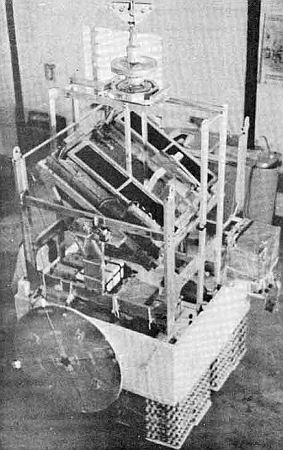Purpose of the flight and payload description
The Xenon filled Multi-anode Proportional Counter telescope was an instrument developed in mid 1980's at the Tata Institute of Fundamental Research, Bombay to observe hard X-ray galactic sources using new techniques based in large area multi-wire proportional counters. The advantage of those detectors was that they offered very large areas, low background, and fairly narrow field of view with relative low weight. It performed 12 flights between 1984 and 1998.
In the image at left we can see the XMPC balloon gondola ready for flight with the two detectors mounted on it (click to enlarge).
THE DETECTORS
The detector system consisted of two identical multianode proportional counters (Detector "A" and Detector "B") each with an effective area of 1230 cm2. The active volume of the detector was arranged in a three layer geometry, with each layer having 4 anode cells of size 48 mm x 48 mm. The alternate anode cells in a layer were linked together and their outputs were given to independent charge sensitive preamplifiers. These layers were surrounded on three sides by a veto layer of individual cell size of 24 mm x 24 mm. The detector was filled with a mixture of xenon, argon and methane at partial pressures of 876, 84 and 90 torr, respectively. With a 0.46 mm aluminum entrance window, the detector had an average X-ray detection efficiency of about 50% between 20 and 80 keV.
A mechanical graded slat collimator made of tin and copper defined the detector field of View to 5º x 5º and 4º32' x 4º6' FWHM for Detector "A" and Detector "B" respectively. Reduction of the non X-ray background was achieved by rejecting all those events in which the signal appeared simultaneously in more than one anode. This condition was however relaxed when two signals appeared simultaneously and one of them had a pulse height corresponding to energy between 25 and 35 keV. This was done to avoid rejection of genuine X-ray events (of energy greater than 34 keV), a large majority of which emit xenon K-fluorescent X-ray, which is subsequently absorbed and detected in one of the detector cells. To further reduce gamma-ray induced background events, the veto layer was used in anti-coincidence with the main detection cells.
Each detector was an independent unit with separate preamplifiers, high voltage unit, electronic logic and analogue to digital converter. The pulse height of every accepted event, stored in 128 channels, and information about the layer in which the event occurred were transmitted every 1.28 ms. Further, there were three data transmission channels independent of the analogue to digital converter: the genuine X-ray events for quick-look data analysis, the integral of the pulse height analyzed events and the total number of events in the veto cells. To check the gain stability of the system, the detectors were calibrated in flight once every 32 min by using the 59.6 keV X-ray line emmited by an Americium-241 radioactive source stored onboard.
THE GONDOLA
The payload was servo-stabilized with respect to the earth's magnetic field by using a flux gate magnetometer. The orientation of the fluxux gate magnetometer with respect to the payload was varied by using a geared motor and in this way the azimuthal angle of the telescope was controlled. The zenith angle of the detectors, mounted on a platform, was controlled by using another geared motor. Two 10 bit absolute shaft encoders were used to measure the azimuth and the zenith angles. The target X-ray sources and the corresponding source-free background regions were tracked alternately throughout the observation. For this purpose, pre-determined source and background region coordinates were stored in a memory in an onboard programmer. The stored values were compared with the shaft encoder outputs and the zenith and the azimuth angles were automatically updated every minute. The data was transmitted to the ground station in real time using a 50 kHz Pulse Code Modulated telemetry system.
Details of the balloon flight
Balloon launched on: 12/11/1991 at D
Launch site: TIFR National Balloon Facility, Hyderabad, India
Balloon launched by: National Balloon Facility, Tata Institute of Fundamental Research
Balloon manufacturer/size/composition: Zero Pressure Balloon Winzen 242.900 m3 (13 microns Stratofilm - Cap 25 microns Stratofilm)
Flight identification number: 416
End of flight (L for landing time, W for last contact, otherwise termination time): 12/11/1991
Balloon flight duration (F: time at float only, otherwise total flight time in d:days / h:hours or m:minutes - ): 6 h 20 m
Payload weight: 681 kgs
Overall weight: 1155 kgs
The balloon was launched from the National Balloon Facility in Hyderabad, on December 11, 1991. After a nominal ascent phase, it reached ceiling altitude at a vertical residual atmosphere of 3.2 g/cm2.
External references
- Balloon-borne observations using a large area xenon detector telescope above 20 keV Advances in Space Research, vol. 14, no. 2, p. (2)109
- Hard X-ray observation of the pulsar GX 1+4 Bulletin of the Astronomical Society of India, Vol. 23, No. 4, p. 478
- Hard X-ray pulse profile of GX1+4 Advances in Space Research, Volume 22, Issue 7, p. 1003
- Hard X-ray spectra of some X-ray binaries from balloon-borne observations Astronomical Society of India, Bulletin, vol. 21, no. 3-4, p. 555
- Hard X-ray spectrum of 4U 1907 + 09 Astronomy and Astrophysics, vol. 268, no. 2, p. 609
14652If you consider this website interesting or useful, you can help me to keep it up and running with a small donation to cover the operational costs. Just the equivalent of the price of a cup of coffee helps a lot.


